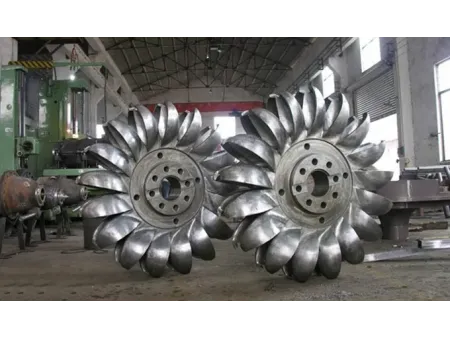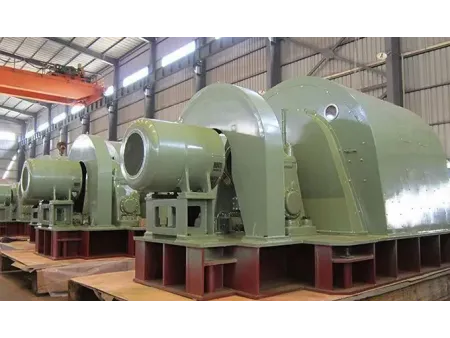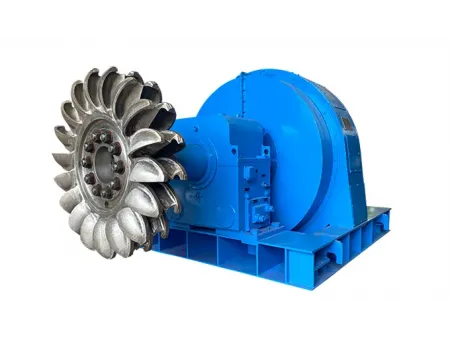- Water head: 200-800m
- Power output: 100kW to 20MW
- Flow rate: 0.3-10m³/s
Pelton Turbine
Pelton turbines are hydraulic prime movers that convert the kinetic energy of water into mechanical energy. This is achieved by using a specialized water guide system to direct a high-speed free jet onto the runner buckets, causing the runner to rotate and perform work. Water from a pressure pipeline is converted into a high-velocity jet through a nozzle, which then strikes the runner tangentially, causing it to rotate. This rotation drives the generator rotor to produce electricity.
Based on the relative position of the working jet to the runner and the number of working jets, Pelton turbines are classified into:
- Tangential flow turbines
- Inclined-jet turbines
- Double-nozzle turbines.
Pelton turbines are particularly suitable for rivers with high head, ranging from 200m to 800m, and relatively low flow rates. In addition, Pelton turbines benefit hydropower plants with their convenient construction, allowing for quick installation, making them a cost-effective and efficient choice for high-head hydropower projects.
- Water head: 210m
- Power: 5000KW (2 × 2500KW each)
- Water head: 260m
- Flow rate: 1.5m³/s
- Power: 2500 KW (2 × 1250KW each)
- Water head: 200m
- Flow rate: 1m³/s
- Power: 2000 KW (2 × 1000KW each)
- Water head: 250m
- Flow rate: 0.3m³/s
- Power: 630KW
- Water Head: 271m
- Flow Rate: 0.5 m³/s
- Power: 800 KW (2 × 400KW each)
- Water Head: 300m
- Flow Rate: 1m³/s
- Power: 2500 KW (2× 1250KW each)
- Turbine runner (drive wheel, main shaft, etc.)
- Nozzle/injector (nozzle and associated control mechanisms)
- Casing (main casing body, cover, bearing housing, etc.)
- Penstock (distribution ring pipe, branch pipes, expansion joints, etc.)
The distribution ring pipe first directs the high-head water flow to the nozzle. Under atmospheric pressure, the nozzle converts the water’s potential energy into jet kinetic energy. The resulting jet impacts the turbine runner’s spoon-shaped buckets (also known as impulse blades), causing the runner to rotate and convert the kinetic energy into mechanical energy. Finally, this mechanical energy is converted into electrical energy by the generator.
What hydraulic conditions make rivers suitable for Pelton turbines?
Pelton turbines are generally suitable for rivers with high head, typically ranging from 200m to 800m, and relatively low flow rates. In addition to their suitability, Pelton turbines offer practical benefits such as convenient construction, requiring less concrete, and allowing for quick installation, making them a cost-effective and efficient choice for high-head hydropower projects.
What is the efficiency of Pelton turbines?
The efficiency of impulse turbines can reach up to 95%. For micro-hydropower plants, the maximum efficiency of Pelton turbines can reach approximately 90%.
What are the typical applications of Pelton turbines?
Pelton turbines are typically used in:
- Hydropower generation
- High-head, low-flow applications
- Water supply systems.
Do you customize Pelton turbines?
Yes, we do! With over 21 years of industry experience, we manufacture Pelton turbines tailored to the customers’ specific head, flow rate, and other requirements.
What makes your Pelton turbines different?
Thanks to our professional team and advanced equipment, we excel in Pelton turbines manufacturing. We provide one-stop solutions with dedicated customer support throughout the inquiry to shipment.




